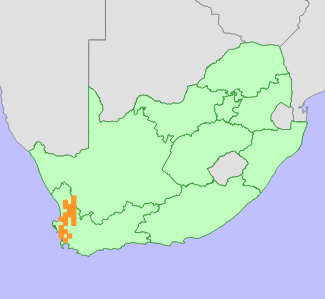|
Scientific Name | Rafnia diffusa Thunb. |
Higher Classification | Dicotyledons |
Family | FABACEAE |
Synonyms | Rafnia retroflexa Benth. (later homonym), not of Thunb. (1800) |
National Status |
Status and Criteria | Near Threatened A4c |
Assessment Date | 2020/03/19 |
Assessor(s) | L. von Staden |
Justification | Rafnia diffusa is a range-restricted species, with an extent of occurrence (EOO) of 13 341 km². It is very common, and known to occur at more than 40 locations. It is however declining rapidly due to ongoing habitat loss to agricultural expansion. If recent observed rates of habitat loss were to continue into the future, a population reduction of at least 20% is likely to be reached within three generations. It is listed as Near Threatened. |
Distribution |
Endemism | South African endemic |
Provincial distribution | Northern Cape, Western Cape |
Range | This species is endemic to South Africa, and occurs from the Bokkeveld Escarpment around Nieuwoudtville southwards through the Cederberg and Sandveld to Malmesbury. |
Habitat and Ecology |
Major system | Terrestrial |
Major habitats | Swartland Granite Renosterveld, Piketberg Sandstone Fynbos, Winterhoek Sandstone Fynbos, Cederberg Sandstone Fynbos, Nardouw Sandstone Fynbos, Western Altimontane Sandstone Fynbos, Olifants Sandstone Fynbos, Graafwater Sandstone Fynbos, Bokkeveld Sandstone Fynbos, Cape Flats Sand Fynbos, Atlantis Sand Fynbos, Hopefield Sand Fynbos, Leipoldtville Sand Fynbos |
Description | It occurs in deep, dry sand on flats or lower slopes in montane fynbos or sandveld. |
Threats |
| About 50% of this species' habitat is already irreversibly modified, predominantly due to historical and ongoing habitat loss to agricultural expansion - mainly rooibos tea and potato cultivation on the Bokkeveld Escarpment and in the Sandveld. |
Population |
Comparable land cover datasets indicate rapid, ongoing habitat loss, with 5% loss recorded between 1990 and 2014. If loss is to continue at a similar rate, it is anticipated that a population reduction of 20-30% could be reached within three generations (generation length is at least 20 years for this species). This species is still very common, and it is protected within the Cederberg Wilderness area, where it is not suspected to be declining.
|
Population trend | Decreasing |
Assessment History |
Taxon assessed |
Status and Criteria |
Citation/Red List version | | Rafnia diffusa Thunb. | NT A4c | 2020.1 | | Rafnia diffusa Thunb. | Least Concern | Raimondo et al. (2009) | |
Bibliography |
Campbell, G.J. and Van Wyk, B.-E. 2001. A taxonomic revision of Rafnia (Fabaceae, Crotalarieae). South African Journal of Botany 67(2):90-149.
Goldblatt, P. and Manning, J.C. 2000. Cape Plants: A conspectus of the Cape Flora of South Africa. Strelitzia 9. National Botanical Institute, Cape Town.
Raimondo, D., von Staden, L., Foden, W., Victor, J.E., Helme, N.A., Turner, R.C., Kamundi, D.A. and Manyama, P.A. 2009. Red List of South African Plants. Strelitzia 25. South African National Biodiversity Institute, Pretoria.
|
Citation |
| von Staden, L. 2020. Rafnia diffusa Thunb. National Assessment: Red List of South African Plants version 2024.1. Accessed on 2025/11/18 |
 Comment on this assessment
Comment on this assessment


